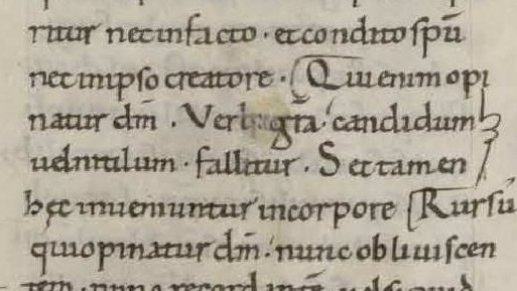This post collects various errors and corrections in manuscripts, and will be added to as more are submitted. If you would like to add your examples below, please email us with images and a description. You must have permission to share the images.
Click to jump to examples of different ways of treating errors and corrections.
A word of warning: inevitably there are overlaps between some of these categories, while some pages will show examples of different treatment of errors.
Erasure
In BNE, Mss/224, a tenth-century copy of St Augustine’s De Trinitate, the scribe has erased an error and written a correction over the top on f. 4r.
There are some more examples on f. 217r:
Barbara Santiago, Universidad Complutense de Madrid (UCM)
The final word on line 15 of f. 12r in Bodleian Library, MS Bodl. 565 has been erased and the rhyme bracket runs through the middle of it. (Side note: you can see that the rhyme bracketing was originally done in the same ink as the verse, and the rubricator has been over it.)
Mary Boyle, University of Oxford
Crossing out
Again in BNE, Mss/224, the tenth-century copy of St Augustine’s De Trinitate, the scribe made an error on f. 24r and wrote some words which were later crossed out:
Barbara Santiago, Universidad Complutense de Madrid (UCM)
When the scribe of Bodleian Library, MS e Mus. 160 decided to lay out his work as a play rather than a narrative, he crossed out formulations like ‘saide X’, and replaced them with speakers’ names in the margin. Here’s an example from f. 141r:
Mary Boyle, University of Oxford
Marginal Corrections
A note in the top margin of MS. Laud Misc. 507, fol. 3r records that the text was corrected at Clairvaux: “Iste liber fuit correctus in Clareualle”:

On f. 9r, we see a clarification of an abbreviation. The corrector wrote ‘posse’ at the end of a line, outside the ruled area, in order to clarify the first word of the following line. It appears the abbreviated form below “pse” was not considered up to the task:

This is a #PolonskyGerman digitisation.
Tuija Ainonen, University of Oxford
The scribe of Merton College MS 126 made a mistake on the opening folio. If he thought no one else would notice, he reckoned without the illuminator drawing everyone’s attention to his marginal correction:
Julia Walworth, University of Oxford
Signes-de-renvoi
These are symbols which show where a correction or insertion should go . They can also be used to indicate a cross-reference.
In late twelfth-century Lambach, the scribe/artist Gottschalk used neumes as signes-de-renvoi to indicate additions and corrections, as in Staatsbibliothek Berlin Ms. theol. lat. qu. 140. Here’s an example on f. 7r:

Lisa Fagin Davis, Medieval Academy of America
The corrections to Bodleian Library, MS. Laud Misc. 507 took various forms. These included additions of text where the scribe had skipped words. A signe-de-renvoi guides the reader to look at the lower margin that has the corrector’s addition (note how the addition repeats ‘horum sponsa’ that is also in the text). This omission was likely set off by the repetition of ‘horum’ in the original text that triggered the scribe to skip some words.

This is a #PolonskyGerman digitisation.
Tuija Ainonen, University of Oxford














Do what appear to be “brackets” / “parentheses” shown in Madrid BNE, Mss/224 indicate something specific, such as later additions or insertions into the text from another manuscript source?
LikeLike